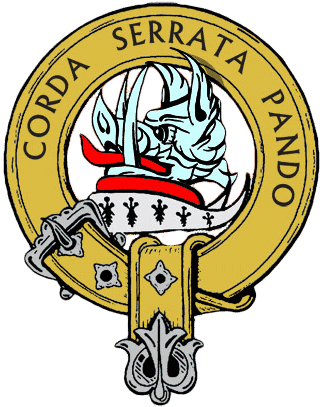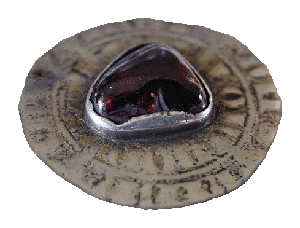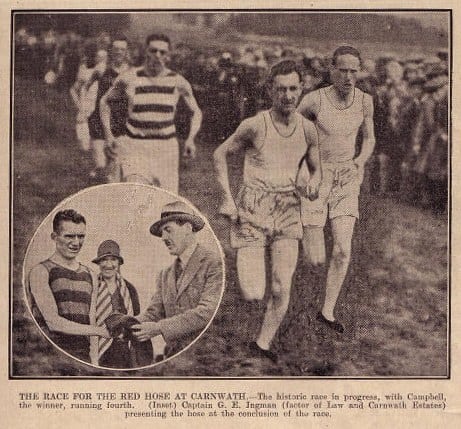History of the Lockharts:
Our motto - "Corda Serrata Pando"

Lockhart Clan Member Crest Badge "Corda Serrata Pando" - I open locked hearts
In early times this name was spelt 'Locard' or 'Lokart'. Like so many Scottish families, the Locards came from England where they were among those dispossessed of lands by William the Conqueror. There were lands of Lockards’ near Penrith in the 12th century and later in Annandale, where the town of Lockerbie is said to be named after them. The family finally settled in Ayrshire and Lanarkshire, where they have held land for over 700 years.
The earliest paper in the family archives is a charter of 1323. By this Sir Symon Locard bound himself and his heirs to pay out of the lands of Lee and Cartland an annual rent of £10. Stephen Locard, grandfather of Sir Symon, founded the village of Stevenston in Ayrshire. His son, Symon, acquired lands in Lanarkshire and, like his father, called a village which he founded, Symons toun (today Symington) after himself.
Symon, the 2nd of Lee, won fame for himself and his family fighting alongside Robert the Bruce in the struggle for Scottish Independence. He was knighted for his loyal service. Sir Symon was among the knights, led by Sir James Douglas, who took Bruce's heart on crusade in 1329 to atone for his murder of John Comyn in the church of Grefriars in 1306. The crusade was ended prematurely when Douglas was killed fighting the Moors in Spain, but to commemorate the adventure and the honour done to the family, their name was changed from Locard to Lockheart, which afterwards became Lockhart. The heart within the fetterlock was from then on included in the arms of the family, and the deed is also commemorated in the motto.
Legend of the Lee Penny
The Lee Penny by Andy Hunter

As well as a new name, the family gained a precious heirloom on the Crusade: the mysterious charm known as the Lee Penny. Sir Walter Scott used the story of its acquisition by the family as a basis for his novel, The Talisman. Sir Symon captured a Moorish Amir in battle in Spain, and received from the man's mother as part of his ransom, an amulet or stone with healing powers. The Amir’s mother told Sir Symon that the stone was a remedy against bleeding, fever, the bites of mad dogs, and the sicknesses of horses and cattle. The amulet was later set in a silver coin which has been identified as a four-penny piece of the reign of Edward IV. The coin is kept in a gold snuffbox which was a gift from Maria Theresa, Empress of Austria, to her general, Count James Lockhart. Such was the belief in the amulet's powers that a descendant of Sir Symon, Sir James Lockhart of Lee, was charged with sorcery, an offense which could carry the death penalty. After examining the accused the Synod of the Church of Scotland dismissed the case, because…
the custom is only to cast a stone in some water and give diseased cattle thereof to drink and the same is done without using any words such as charmers use in their unlawful practices and considering that in nature there are many things seem to work strange effects whereof no human wit can give reason it having pleased God to give the stones and herbs a special virtue for healing of many infirmities in man and beast.
Alan Lockhart of Lee was killed at the Battle of Pinkie in 1547. Sir James Lockhart of Lee, born in 1596, was appointed a gentleman of the Privy Chamber by Charles I and was knighted. In 1646 he was appointed to the Supreme Court Bench, taking the title of 'Lord Lee'. A zealous royalist, he was captured at Alyth in 1651 and conveyed to the Tower of London. His son, Sir William, was a distinguished soldier who fought on the royalist side at the Battle of Worcester in 1651. He then campaigned on the continent, where he achieved such prominence that Cardinal Mazarin, successor to Cardinal Richelieu, offered to make him a Mareschal of France. He died in the Netherlands in 1675.
James Lockhart, who inherited the estates in 1777, also saw service on the Continent where he rose to be a count of the Holy Roman Empire, a Knight of the Order of Maria Theresa and a general of that Empress Imperial forces. The title of Count became extinct when James's only son, Charles, died without issue.
Although the family seat of the Lee Castle itself has been sold, the estate land acreages are still owned and managed by the present head of the Lockhart clan.

 The Red Hose Race
The Red Hose Race
The lands and barony of Carnwath are held direct to the Crown, and under the Crown Charters the Crown Vassal (Proprietor) is bound by the reddendum or rent clause to pay:
One pair of hose containing half an ell of English cloth at the Feast of St. John the Baptist, called Midsummer, to the man running most quickly from the East end of the town of Carnwath to the Cross called Cawlo Cross in name of blench ferme only.
The Crown Charter in which this peculiar reddendum first appeared is dated 13th March, 1508, and was granted by King James lV to John, third of Somerville.
There was a military reason for imposing this duty on the owners of Carnwath. A fast runner could bring news of any approaching ['English'] invasions from the South to Edinburgh, and the runner wearing Red Hose (Hose is the Scots word for stockings or long socks) would be the message seen by which would be recognized along the main road.
With the passage of time, some of the original requirements and traditions attached to the race have changed or disappeared. No longer is the race held on Midsummer day; no longer is the name of the winner proclaimed from the Mercat Cross in Edinburgh. The race must still be run, however, to meet the requirements of the Crown Authorities whose written permission is necessary before the performance of the service can be suspended; as for example, during a national emergency such as war, and in the case of a local exigency such as the outbreak of Foot-and-Mouth Disease. In fact these are the only instances known in which the Crown Receiver has sanctioned its suspension.
The race, which is the oldest foot-race in Scotland has been run on the Village Green from time immemorial, and is now usually held on Carnwath Gala Day in June.
Although the Charters do not stipulate the colour of the stockings, it is now legendary that they should be red. They are knitted locally by Mrs. Dornan, and for many years were knitted by Mrs. Dewar, mother of the Head Gamekeeper on the Estate and widow of a former Estate tradesman.
Between 1951 and 1966 a record was established by Mr. Michael Glen of Bathgate who won the mile long race 14 times in that period. Later in 1966 an alteration was made, with the consent of the Crown Authorities to the Rules governing the entries to the race so that only residents in the Parishes of Auchengray, Braehead, Carnwath, Carstairs, Covington, Dolphinton, Dunsyre, Elsrickle, Forth, Libberton, Quothquan, Thankerton and Walston may compete. Any employee of the Estate or of any of the Estate Tenants may also enter.
At this time too a cup was presented known as the McLarty Cup, in memory of the late Mr. A. M. McLarty who was Assistant Factor and had 35 years service with the Estate; the cup goes to the competitor coming in first who is either a resident in a house the property of the Estate, or is employed by the estate or any tenant of the Estate. This qualification excludes feuars; no one shall be allowed to compete for either the Red Hose or the McLarty Cup who has won either of them in three successive years.